"Savitri" (2019)
Drawn in ink and pencil. This sketch is of the famous South Indian Telugu actress, Savitri (1934-1981) who dominated the South Indian film industry in the 50's and 60's. This illustration of her is taken from a scene in one of her film's songs, in which she stands decked in a sari, her hair adorned with a halo of jasmine flowers, a high hairbun, and a long, signature bottu/bindi on her forehead. She was easily recognizable via her distinct beauty: an oval-shaped face and wide eyes lined with kaatika (kohl). Hence, her style and features were the focus of this sketch.
More from this Category:
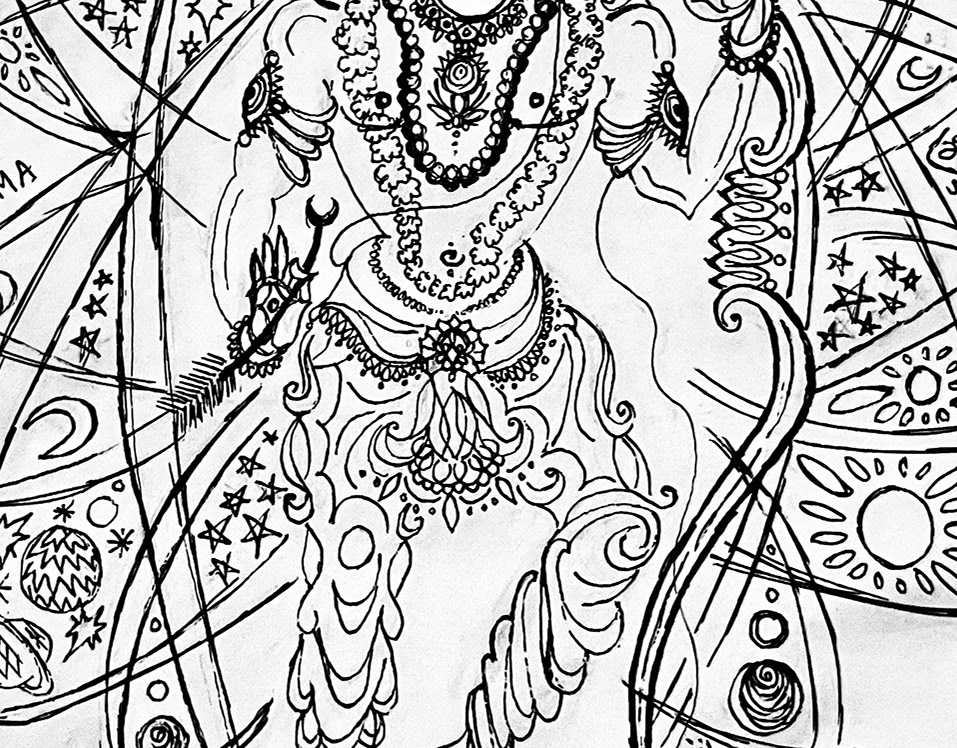
"Universe, Balance: Rama" (2023)
Created with ink, draft (scroll down) created with pencil. This illustration depeicts the Hindu god Sri Rama as the center of the universe, providing balance between opposing sides. He carries an arrow (with a crescent-shaped head, similar to that of ancient Indian arrows, which had different shapes) and bow whose string curls around his arms. His crown, belt, and jewelry indicate his status as a warrior king, and a sun-like halo surrounds his head. His forehead is covered in the symbol of the god Vishnu, whom he is the incarnation of. His pants are drawn stylistically to show draped silk. His feet have small sparks next to them. He is surrounded by a structure which contains suns and moons, planets and stars. Rama's name, in English, Telugu, and Hindi, is written amongst these parts of the universe. The structure symbolizes both the universe and an atom: to suggest that Rama is present in the largest scale and smallest scale. In this illustration, centering him within the smallest particle is a reference to Telugu poet Annamacharya's writing on the same subject. Finally, the sacred syllable "Om" outlines the structure. Note: This piece was intended to be the first in a series of illustrations for a devotional kirtan (song) about Rama, written by the late Dr. Advikolanu Muralidhar. So, this imagery reflects the lyrics. This style of art is inspired by the Vedic Art style, hence the curved body of the male figure, the oval-shaped face, and elaborate ornaments.
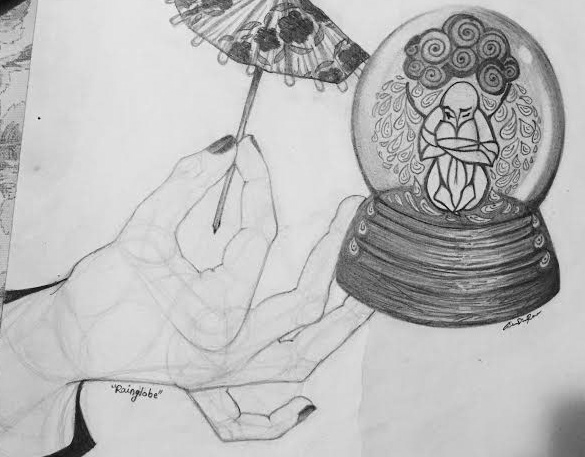
"Rainglobe: Trapped Angel" (2016)
Illustrated with pencil for a Drawing class assignment, in which students were instructed to create a piece that incorporated a hand, an object, and glass. Thus, this illustration is of a small, isolated, angelic figure trapped in a globe. A raincloud in the globe showers onto them, and the feathery drops turn into wings. Hence, the title of the piece. Meanwhile, outsiders attempt to offer comfort, represented by a hand holding a cocktail umbrella up to the glass. However, their efforts are futile; the figure is beyond their reach, and it will take more than a frail umbrella to shatter the glass. The figure, drafted in the second image below (you'll see it when you scroll down), has wrapped their limbs into a near-fetal position. They peek out at the hand, at the comfort being offered, but do not engage with it. Note the use of shading in the glass and wooden base of the globe, the high contrast of the figure's outline, a spot of light upon the glass, and the mechanical drawing style of the hand which breaks it into its simplest forms.

"Flute Choir: Winter Concert" (2022)
Brochure designed using ink. Each piece from the concert repertoire was incorporated. For instance, "Stained Glass Windows" was a general theme, hence the entire piece is framed into a classic, Gothic window. The upper panel represents "March of the Planets," the rose beneath the planets represents the "Roses" piece, and the upper-left panel represents "La La Land: City of Stars," in which Emma Stone dances beside 5-star film ratings and a streetlight (which is reflected on the right panel's border). The upper-right panel contains Georges Bizet's "Carmen" via a sweeping skirt covered with the hearts of men who fall for Carmen. The central plum symbolizes the "Sugar Plum Fairy," the reed flutes lining the lower left and right panels' edges are from the "Dance of the Reed-Flutes," all from Tchaikovsky's "Nutcracker Suite." "March" from "Nutcracker" is combined with the "March of the Toys" piece in a soldier-teddy-bear playing piccolo on the lower right panel. "I Have a Dream" from "Les Misérables" is captured on the lower left panel through the girl from the novel's book cover. Finally, "Treasures Under the Sea" is portrayed through treasure chests and seaweed in the lowermost panel. Bold lines and reflective scripts are used to highlight the concert date as window shutters. The "Bi-Co" or bi-college is similarly kept in thick, sharp angles, with "Winter Concert" script kept in diminishing/growing font. The entire brochure design exemplifies symmetry and harmonious composition.

"Peacock Dancer" (2022)
Ink drawing of a Bharatanatyam (South Indian Tamil classical) dancer. The hand gestures are "Mayuram" which means peacock, and the pose taken by the dancer is a peacock pose. Hence, the body is surrounded by peacock feathers. Intricate details in the jewelry, lotuses in the hair, delicate feathers, and bold eyeliner are the focus of this piece. The pleats of the skirt, painted marks on the feet and hands, and bells on the feet, are all features of a Bharatanatyam costume.
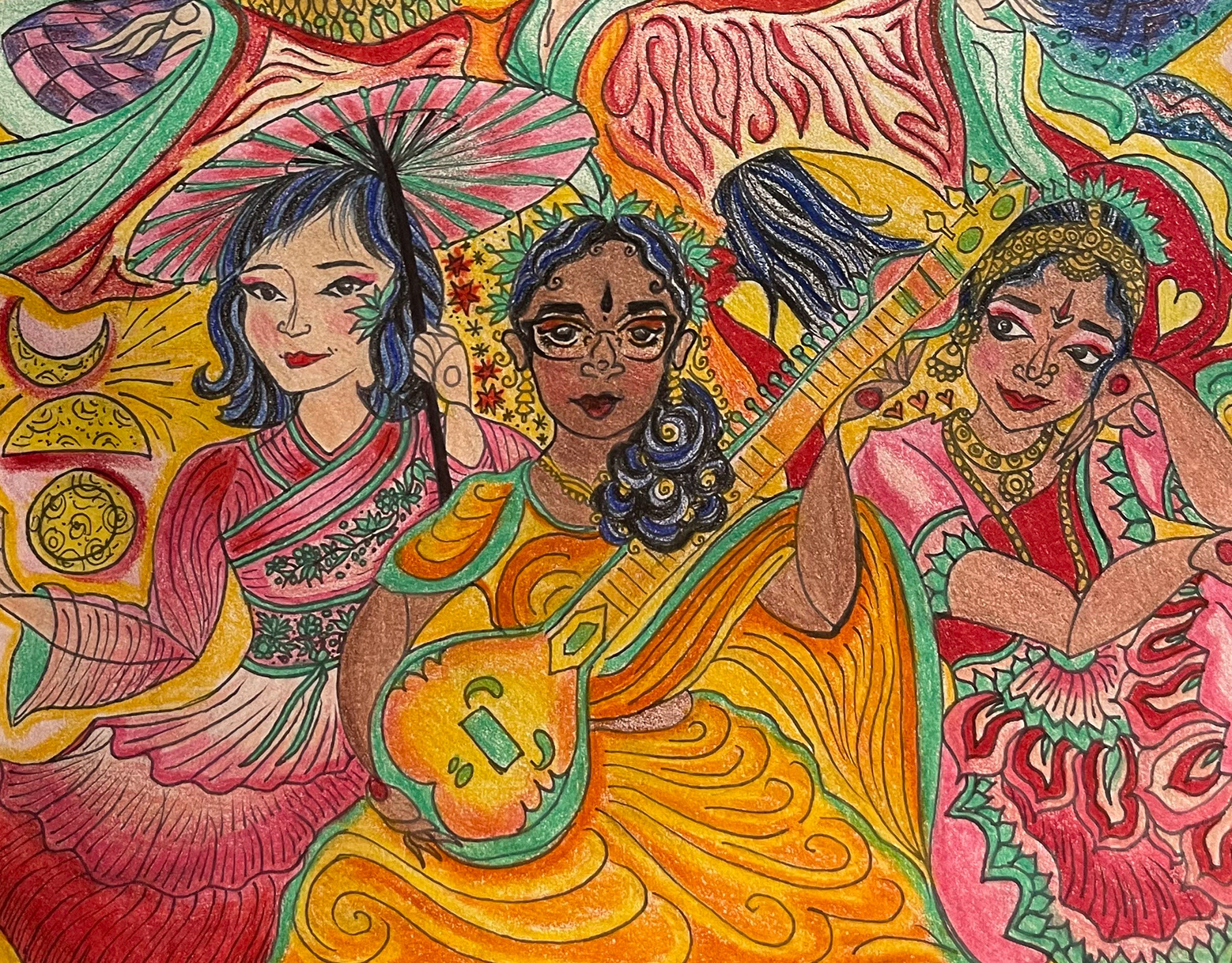
“Indo-Chinese Classical Dance" (2024)
Drawn with colored pencil and ink based on ink outline (see "Draft" in Poster section of portfolio). Each dancer is based on reference photographs of traditional Chinese classical dance costumes and traditional Indian classical dance/music costumes (Bharatanatyam, Odissi, Carnatic). Motifs associated with each culture, including a parasol and a sitar, are included. A bold, gradient color scheme which suits both cultures was applied to the clothing, hair, and backdrop. Each figure's costume, makeup, hairstyle, and accessories is distinct. Figures are arranged and layered on the poster to show people sharing classical arts and cultural spaces with each other. Motifs of the moon and the stages of love, which was the showcase theme, is included to the bottom left (moon phases) and bottom right (small hearts). Symmetry and balance was achieved by keeping figures in parallel poses and parallel colors. Finally, the cursive script used for the description stands in contrast with the showcase information, title, and the dance clubs' names (Mei-Kala). A bold, curved script was used to match the curves and angles of the performers' bodies.

"The Suicide Pact" by Dr. Advikolanu Muralidhar (2021)
Book cover and jacket designed using Adobe Illustrator for "The Suicide Pact," an English play by Dr. Advikolanu Muralidhar, a South Indian Telugu poet and writer. The central lesson is highlighted on the back cover. Each element from the set design and the themes/events themselves are illustrated. The play centers on a professor and his artistic wife, Lalitha, who despise one another, themselves, and their lives. One night, they draft a suicide pact. Since the play occurs over one night, the book spine, and the book cover's ceiling fan contains a single moon. The ceiling fan, with a sari and tie hanging from it, implies potential death looming over the characters' heads. The eye in the fan represents the audience bearing witness, who ultimately decide the story's conclusion. One line from the fan spirals into two, connecting to "U" and "I" to symbolize individuals, once united in love, now estranged. The wall has several symbols: There are two portraits of a hanging, one with and one without the head attached, to show both potential conclusions to the story. There is Lalitha's scribble next to the hangings, as she laments the meaninglessness of art and art critique. A sketch of a mother and child is drawn by Lalitha yet slashed to show her lost dream of motherhood. A question mark and quotation marks show how the majority of the play is dialogue with existential questions. The quotation marks also hint at the professor's monologue about the pointlessness of speech. A cage from the set design provides a feeling of being trapped in marriage/life. Cigarettes, a watch, a fountain pen, bangles, an ashtray and the suicide pact itself, are laid out on a table. The mangalsutra (wedding necklace) lies discarded, to show the dissolvement of marital bonds. The professor's glasses are cracked, to show distorted perspectives. The table doubles as the Bombay apartment where the characters reside, with shattered windows on one side and windows with the words "You, Me" scribbled on in Telugu. "You, me" is a phrase repeated when the characters are in love, yet those words change their meaning that night. The last letter of "Me" and the first letter of "You" are the same in Telugu, hence they merge initially (to symbolize unity in love) and gradually separate and reflect (to symbolize distortion of the self and separation in marriage) on the apartment and on the back cover's lower border.
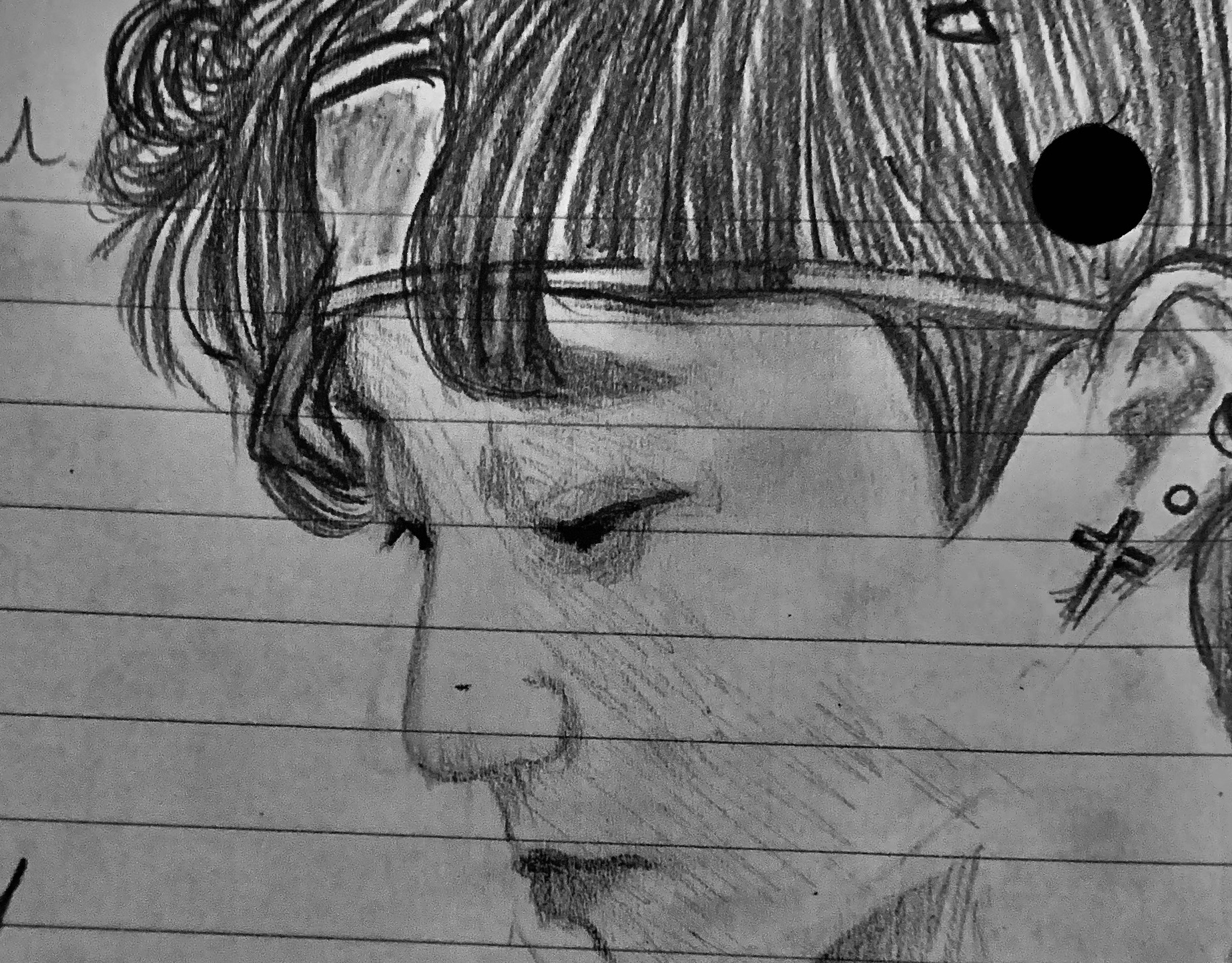
“Beomgyu” (2019)
Freehand sketch with pencil. This illustration is of Beomgyu, a Korean pop idol from the band, "TXT (Tomorrow by Together)". The aim of this piece was to practice drawing a three-fourths profile of a male subject. Focus was kept on bringing out the eyelashes, subtle lips, and hair. This was drawn in a realistic style, to test the artist's ability to capture a subject quickly.
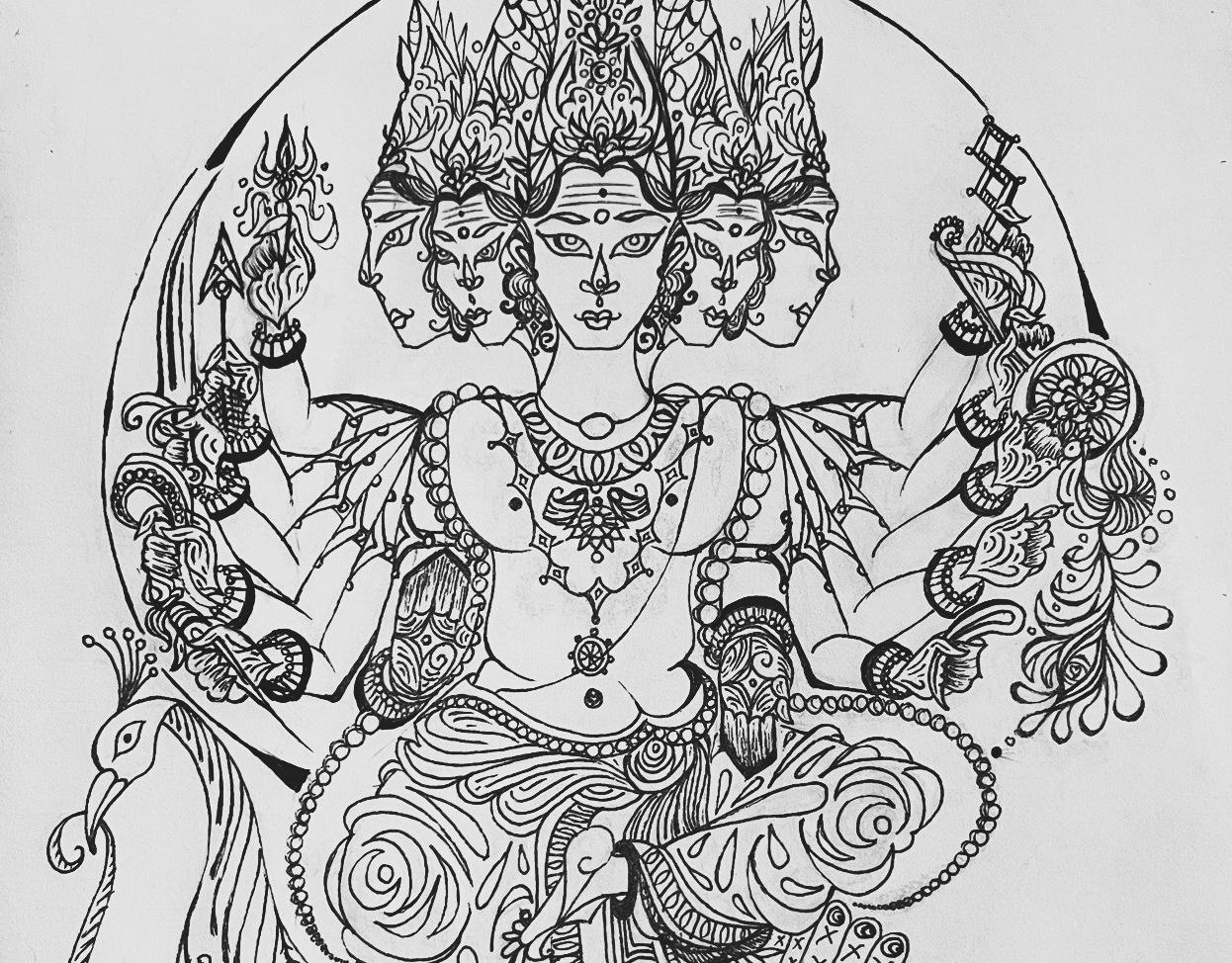
"War God: Karthikeya" (2024)
Drawn with ink. This piece depicts the five-headed, ten-armed form of Karthikeya, the Hindu god of war. His vehicle is a peacock which bites a snake, representing the triumph of good over evil. He carries different weapons in his hands, including: a sword, a trident, an arrow, a bow, a shield, and a noose. In his third arm on the right, he carries a rooster, which is his symbol. Each of his foreheads is marked with the symbol of his father, Shiva, and each of his heads are tilted in a different direction. A halo glow fits around in body in a circle. His chest is adorned with jewelry and his pants are drawn stylistically to show their draping. His first and second hands are facing forward to bless the onlooker. This piece is inspired by Raja Ravi Varma, the Indian painter who often chose mythological figures as his subjects. There is intense detailing in the crown and in the hands, as well as the attention to maintaining general symmetry in the arms and heads. The style of the peacock is inspired by Russian Orthodox icons. Note: the number of heads and arms is symbolic for deities in Hinduism, and the artist wanted to challenge herself with this piece, hence the outcome!

"Tamilian Grandmother" (2014)
Freehand ink sketch of a South Indian Tamilian grandmother with two nose stud piercings. The style of her bottu/bindi is also associated with Tamil culture. For the sake of the sketch and in a break from the typical bottu/bindi, this design is repeated along the bridge of the nose. The eyes are slender and wing-shaped; the tinge of blue in them represents the onset of old age in a dark eyes. The hair is shown to be white and black, and bursting flowers are tucked behind both of the grandmother's ears. Her necklace is shown in the upper-right of the sketch. A hint of colored pencil was used to color the blue-green in her eyes and in her face. The lips are curved to indicate a hidden smile. This style is influenced by Bapu, a South Indian Telugu artist.
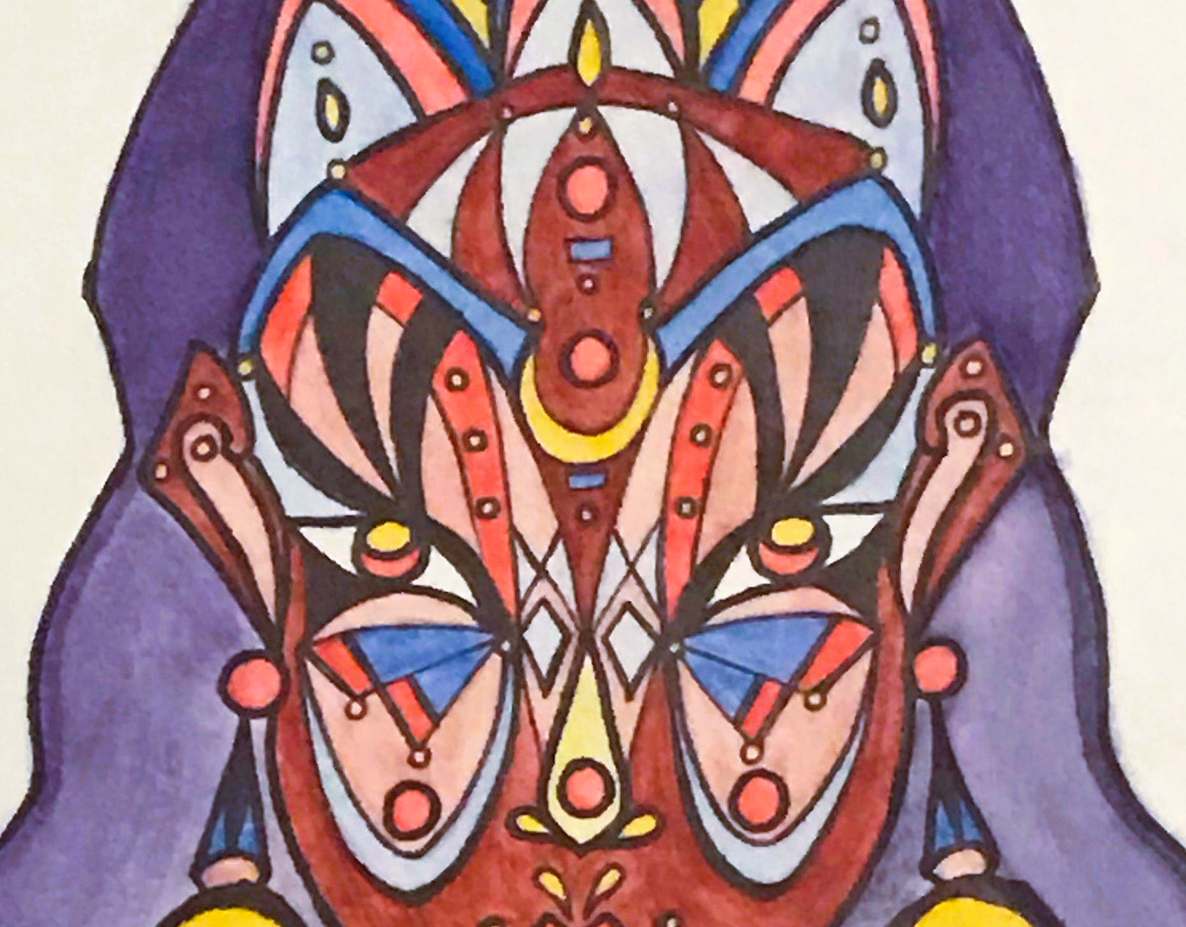
"Crescent Woman" (2014)
Watercolor pencil and ink painting of a woman, inspired by traditional African masks and South Indian Tamil style bottus (spiritual third eyes and marks of which Hindu deity one worships). This features the artist's love for finding and bringing out symmetry with geometric shapes in human faces, namely focusing on crescent, circular, and triangular shapes. Style is also influenced by Bapu, a South Indian Telugu artist who worked with bold colors and continuous lines.